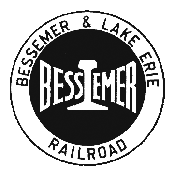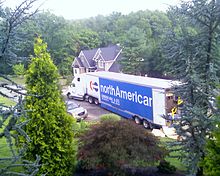
Railroad classes are the system by which freight railroads are designated in the United States. Railroads are assigned to Class I, II or III according to annual revenue criteria originally set by the Surface Transportation Board in 1992. With annual adjustments for inflation, the 2019 thresholds were US$504,803,294 for Class I carriers and US$40,384,263 for Class II carriers.

The Norfolk and Western Railway, commonly called the N&W, was a US class I railroad, formed by more than 200 railroad mergers between 1838 and 1982. It was headquartered in Roanoke, Virginia, for most of its existence. Its motto was "Precision Transportation"; it had a variety of nicknames, including "King Coal" and "British Railway of America". In 1986, N&W merged with Southern Railway to form today's Norfolk Southern Railway.

The Bessemer and Lake Erie Railroad was a class II railroad that operates in northwestern Pennsylvania and northeastern Ohio.
Caliber System Inc., known until 1996 as Roadway Services Inc., was a transportation holding company based in Akron, Ohio, United States. During its history, Caliber owned a number of logistics companies including Roadway Express, Viking Freight and Roadway Package System (RPS) among others. Roadway Express was spun off in 1995 and Caliber was acquired by FedEx in 1998 with subsidiaries becoming FedEx Ground, FedEx Freight, FedEx Custom Critical and FedEx Global Logistics.

The Elgin, Joliet and Eastern Railway was a Class II railroad, making a roughly circular path between Waukegan, Illinois and Gary, Indiana. The railroad served as a link between Class I railroads traveling to and from Chicago, although it operated almost entirely within the city's suburbs, only entering Chicago where it served the U.S. Steel South Works on the shores of Lake Michigan. Nicknames for the railroad included "The J", EJ&E and "The Chicago Outer Belt Line". At the end of 1970, the EJ&E operated 164 miles of track and carried 848 million ton-miles of revenue freight in that year alone.

Pan Am Railways, Inc. (PAR) is a subsidiary of CSX Corporation that operates Class II regional railroads covering northern New England from Mattawamkeag, Maine, to Rotterdam Junction, New York. Pan Am Railways is primarily made up of former Class II regional railroads such as Boston and Maine Corporation, Maine Central Railroad Company, Portland Terminal Company, and Springfield Terminal Railway Company. It was formerly known as Guilford Transportation Industries and was also known as Guilford Rail System. Guilford bought the name, colors, and logo of Pan American World Airways in 1998.
Con-way, Inc. was an American multinational freight transportation and logistics company headquartered in Ann Arbor, Michigan, United States. With annual revenues of $5.5 billion, Con-way was the second largest less-than-truckload transport provider in North America, with additional operations for global contract logistics, managed transportation, truckload and freight brokerage. The company's services were sold through its primary operating companies of Con-way Freight, Con-way Truckload and Menlo Worldwide. These operating units provided less-than-truckload (LTL), full truckload and multimodal freight transportation, as well as logistics, warehousing and supply chain management services. Con-way, Inc. and its subsidiaries operated from more than 500 locations across North America and in 20 countries.
Consolidated Freightways (CF) was an American multinational less-than-truckload (LTL) freight service and logistics company founded on April 1, 1929, in Portland, Oregon, and later relocated to Vancouver, Washington. Affectionately known as "CornFlakes", Consolidated Freightways was also the founder of the Freightliner line of heavy trucks, now owned by Daimler Trucks. At its height, the company possessed over 350 terminals, employing more than 15,000 truck drivers, dock workers, dispatchers and management. Consolidated Freightways was once the nation's number one long-haul trucking company and the 3rd largest-ever US bankruptcy filing, ceasing business in 2002.

Yellow Corporation was an American transportation holding company headquartered in Overland Park, Kansas. Its subsidiaries included national less than truckload (LTL) carrier YRC Freight; regional LTL carriers New Penn, Holland, and Reddaway; and freight brokerage HNRY Logistics. From 2006 to February 2021, Yellow was known as YRC Worldwide.
Allied Van Lines is an American moving company founded in 1928 as a cooperative non-profit organization owned by its member agents on the east coast of the United States, to help with organizing return loads and minimizing dead-heading. In 1968 it was reorganized as a standard public company, with shares. In 1999 it merged with its larger competitor, North American Van Lines, and the combined entity then came under the holding company Allied Worldwide. In 2002, Allied Worldwide was renamed SIRVA.

Celadon Group, Inc. was a truckload shipping company located in Indianapolis, Indiana. It was one of the ten largest truckload carriers in North America and at its peak operated 4,000 trucks and owned an additional 11,000 trucks through Quality Equipment, its leasing division.

Swift Transportation is a Phoenix, Arizona-based American truckload motor shipping carrier, part of Knight-Swift. With over 23,000 trucks, it is the largest common carrier in the United States. In 2017, Swift merged with Knight Transportation, also of Phoenix.
Roadway Express, Inc. was an American less than truckload (LTL) trucking company. Roadway Express and its holding company, Roadway Corporation, were acquired by logistics holding company Yellow Corporation in 2003, and the parent companies were merged to form Yellow Roadway Corporation, later renamed YRC Worldwide. In 2009, Roadway Express was merged with YRC's other national LTL carrier, Yellow Freight, to form YRC, Inc.
SIRVA, Inc., based in Oakbrook Terrace, Illinois, is a privately owned American moving industry holding company which resulted from the merger of Allied Van Lines with North American Van Lines. The corporate name was coined from the Latin word servire, "to serve."
The Great Lakes Greyhound Lines, a highway-coach carrier, was a Greyhound regional operating company, based in Detroit, Michigan, USA, from 1941 until 1957, when it merged with the Northland Greyhound Lines, a neighboring operating company, thereby forming the Central Division of The Greyhound Corporation, called also the Central Greyhound Lines.
Transtar, Inc. is a subsidiary of US Steel. It was organized in 1988 to own US Steel's railroad and other transportation subsidiaries. In the third quarter of 2021 it will be taken over by Fortress Transportation and Infrastructure Investors.
The following is a brief history of the North American rail system, mainly through major changes to Class I railroads, the largest class by operating revenue.
The following is a brief history of the North American rail system, mainly through major changes to Class I railroads, the largest class by operating revenue.

AAA Cooper Transportation (ACT) is an American, non-union less than truckload (LTL) freight carrier based in Dothan, Alabama. The company also provides dedicated, port, and international freight transportation. The company was founded in 1955 by John H. Dove after he purchased an interest in P.C. White Truck Lines. It was owned and operated by the Dove family for most of its history.









